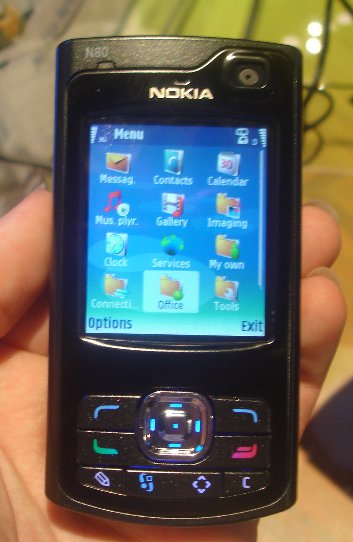 Introduction
Introduction
With a slide form factor the Nokia N80 is reminiscent of the first S60 smartphone, the 7650. However, appearances are deceptive because three years of development have resulted in a phone several generations more advanced.
Design
The N80 is pleasing to the eye and is finished in a mixture of chrome and metal, similar in feel and looks to the N70, which gives the whole device a substantial feel. The N80 will be available in two versions – silver and black, both are constructed of similar materials, but the black version has the advantage of hiding smudges and fingerprints more than the silver version.
In the hand, in slide closed mode, the phone at 95.4 x 50 x 23.4 mm is essentially the smallest Nokia S60 phone yet. As a slider it is a few mm thicker than a monoblock such as the 6680, but this is hardly noticeable. It is bigger and heavier (134g) that the other modern S60 Slider, the Samsung D720, but that is a reflection of the extra functionality found in the N80.
The slide mechanism itself is a soft slide, similar to the camera slide on the N70, which because it lacks the snap feel of spring-assisted slides, may not be to everyones taste. With all the major control keys accessible in slide closed mode (a notable improvement over the 7650) there is very little need to open the slide except when writing messages or inputting other data. The result of this is that the N80 looks and feels much more like a regular phone.
The tactile feedback and ease of use of the control keys are excellent, although the proximity of the softkeys, control pad and calls keys may cause trouble for those with large fingers. The number keypad is not as good, the demo models having a slightly spongy feel, and (as with other sliders) the first row of keys is a little obscured by the top of the phone. On the plus side, the keys are large and well distributed, which should provide for some fast input speeds. Furthermore the usual issue with slide down key pads giving an unbalanced feel when in use is countered by the major portion of the weight of the phone being in the slide down portion.
The screen resolution, at 352 x 416 pixels and with 262,144 colours, is crisp and bright. This is the best screen I have seen on a mobile device, and it outdoes the impressive QVGA screens found on the N92 and N71.
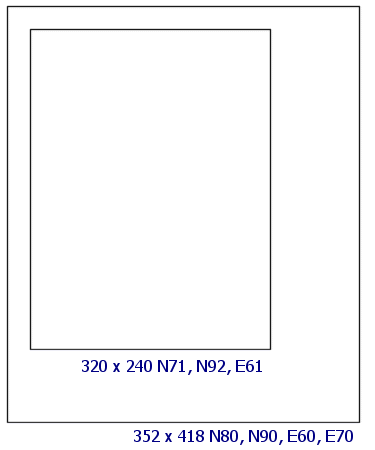
When using the camera, the screen switches to landscape orientation and the phone is held like a traditional camera. There is a dedicated camera key on the side of the phone which, when the phone is held on its side, is in the same location as the shutter key would be on the camera. The result of this reorientation, physically and on the screen, is to give an excellent and intuitive user experience in camera mode.
I think the overall design of the phone in hardware matches well with the S60 software platform ethos of providing enhanced usability and performance, with simplicity at first glance and complexity at second glance for those who need it.
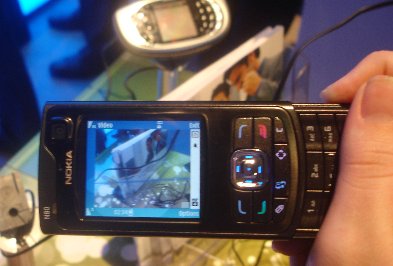
Connectivity
The N80 is the first smartphone that can be truly described as a modern world phone. With quad band GSM (850/900/1800/1900) and either 1900 (US) or 2100 (Europe) WCDMA radios, it will work almost anywhere in the world. The dual band WCDMA means the N80 will almost certainly be making an appearance in the USA (on Cingular) which up until recently has had few S60 devices widely available. Data is well provided for with 3G (384 kbps), EDGE (236 kbps) and GPRS making up the cellular options and WLAN (802.11g) providing a further option. As on the Nokia 9500 and 9300i WLAN works like any other connection and can be used for browsing, e-mail or any other network connection application. Software built into the phone allows you to scan for and connect to any available hotspot. The WLAN is used for the UPnP support which we discuss further below.
Bluetooth 2.0 means support for fast data transfer rates and better performance in a multi-link situation, and the addition of the A2DP profile provides support for stereo Bluetooth headsets and other advanced audio capabilities. (Update: The release version will have Bluetooth 1.2 - it will still support EDR [faster data transfers], but the A2DP profile does not appear to be included).
Interestingly, infrared seems to be making something of a comeback on S60 devices and is present in the N80. Having been absent in some of the recent high end devices Nokia have added it back after demand from users.
Software
The N80 uses S60 3rd Edition on top of Symbian OS 9.1, and in the N92 preview we briefly touched on the changes that S60 3rd Edition brings: high resolution screen support, landscape orientation, improved general user interface and improved standard applications. The N80 takes advantage of these too, although landscape support is only used in camera mode (in contrast with the E60, there is no screen re-orientation option).
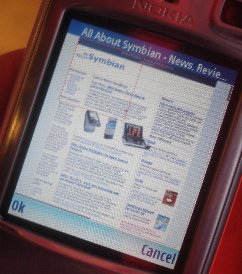 High resolution screen support makes a real difference – physically the screen has not changed in size, but the increased density of the pixels results in a much crisper display. More importantly, many applications are able to take advantage of this, and thanks to the use of vector graphics and fonts throughout the user interface, readability is improved throughout. Phone screens often suffer from the pixelation effect because they tend to be held quite close to the eye, but with the increased pixel density here, graphics and text on screen look less blocky. This is down to the hardware, but the software changes that allow and take advantage of this are considerable.
High resolution screen support makes a real difference – physically the screen has not changed in size, but the increased density of the pixels results in a much crisper display. More importantly, many applications are able to take advantage of this, and thanks to the use of vector graphics and fonts throughout the user interface, readability is improved throughout. Phone screens often suffer from the pixelation effect because they tend to be held quite close to the eye, but with the increased pixel density here, graphics and text on screen look less blocky. This is down to the hardware, but the software changes that allow and take advantage of this are considerable.
The new S60 browser, based on Safari's WebCore and JavascriptCore components, is also found on the N80. The 'minimap' feature allows you to see a full page at a glance and navigate around it, while other new features include 'visual history' and support for RSS feeds. The new browser will provide Opera and NetFront with significant competition. However, Opera, with its recent 8.5 release, comes close to providing similar functionality and continues to innovate at a pace unlikely to be matched by Nokia because of constraints imposed by being part of the platform offering.
In use, the browser is much faster than Nokia's previous efforts and comes much closer to Opera and Netfront performance levels. The new browser will start to change the way people think about browsing the web on a mobile device. Previously, sites aimed at PCs were only accessible using SSR (small screen rendering) technologies and this had usability problems since it was always limited by the intelligence of the re-rendering algorithms. Higher resolution screens, together with minimap, mean that it is possible to quite comfortably view any web site on the phone. Shown in the photo is the full All About Symbian front page displayed on the phone, which should give you an idea of the possibilities.
The RSS capabilities are still being developed – at the moment there is no self-discovery, feeds must be updated manually. In essence the functionality was little more than an RSS file renderer. However, Nokia did say that there was more work to do in this area before release.
The software bundle that ships with S60 devices continues to grow. Quickoffice (Word, Excel, and Powerpoint viewers) will become a standard part of the platform with 3rd Edition, thanks to Nokia's recent licensing of the software from Quickoffice Inc.
Nokia's Mobile Search will ship with the device. This application is designed to make searching from the mobile for both web and local information easier. It is a client application which returns results to the phone within the application. More information is available in our earlier feature.
Flash Lite also looks set to become a standard part of S60 and the N80 will be one of the first handsets with Flash Lite (1.1) supported out of the box. Flash Lite is becoming an increasingly popular solution for creating small micro-apps. These range from small games to front ends for displaying data retrieved from the Internet, such as weather or traffic information, dictionary look ups and news headlines. Flash Lite 1.1 brings several improvements include support for SVG-Tiny playback and additional audio and ActionScript support. Nokia see Flash Lite as a way of leveraging the Macromedia developer base, and Macromedia see it as a way of extending their reach into the mobile space. For the end user, it means a great variety of graphic and animation rich applications. It is likely that operators will use this for delivering services directly to the phone, as it is being pioneered by 3 in Italy and T-Mobile in the UK.
Java support has once again improved with 3rd Edition, which supports a comprehensive range of JSRs on top of J2ME MIDP 2.0. New in 3rd Edition are Security and Trust Services API (JSR 177), Java Location API (JSR 179), Session Initiation Protocol (SIP) API (JSR 180), Wireless Messaging API (WMA) 2.0 (JSR 205) and Scalable 2D Vector Graphics API (JSR 226) adding to those already available: Mobile 3D Graphics API (JSR 184), Java™ APIs for Bluetooth (JSR 82), FileConnection API (JSR 75), Wireless Messaging API (JSR 120) and Mobile Media API (JSR 135).
The full complement of S60 applications is present, from Calendar to Gallery, which means that many users will never feel a need to add applications. Of course, this misses out on a huge part of the potential of S60 devices. Nokia continues to highlight additional software and hardware solutions for S60, be they multimedia and entertainment, GPS navigation or office productivity. In the renaming of Series 60 to S60 and the tag line of 'Open to new features', Nokia clearly realise there is a need for user education. It remains to be seen whether this will work and how far Nokia will go, but it is both a very encouraging and necessary step.
Multimedia
The N80 boasts a 3 megapixel camera which, despite the lack of an auto-focus, should produce some excellent results. There are two focus modes supported: close up mode (17.5 cm to 23.4 cm) and normal mode (68 cm to infinity) which does mean macro shots should be improved over previous S60 phones. The camera software is increasingly sophisticated, with self timer, advanced sequence mode, 10 scene modes and brightness, contrast, sharpness, colour saturation, white balance, exposure compensation and colour tones adjustments, image quality settings and video stabilisation. Pictures can be printed via Bluetooth (via the BPP Bluetooth profile), infrared, Wi-Fi or USB. Video capture resolution at 352 x 288 is also impressive, as on the N70 and N90. The usual LED flash is provided, which should be good for subjects up to 3 metres away. There is also a VGA camera mounted on the front of the device for video calls.
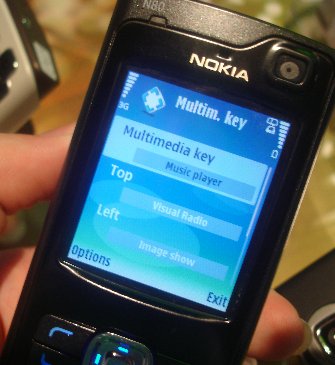 The N80 is part of the Nokia XpressMusic brand, and as such has the capability to sync (with Windows Media Player and others) and transfer music to and from a PC (the phone will act as a USB Mass Storage device when connected), playback Janus DRM protected WMA files (in addition to MP3, AAC, and AAC+) as used by many Internet music stores, easy playlist management (including sharing with other users wirelessly), and the ability to use 3.5mm audio plug headphones via an adaptor. One of the big selling points is that it supports UPnP, which we cover in more detail below.
The N80 is part of the Nokia XpressMusic brand, and as such has the capability to sync (with Windows Media Player and others) and transfer music to and from a PC (the phone will act as a USB Mass Storage device when connected), playback Janus DRM protected WMA files (in addition to MP3, AAC, and AAC+) as used by many Internet music stores, easy playlist management (including sharing with other users wirelessly), and the ability to use 3.5mm audio plug headphones via an adaptor. One of the big selling points is that it supports UPnP, which we cover in more detail below.
The phone also includes Nokia XpressShare , which is branding for the sharing of multimedia between users. This includes Video Sharing, which has been pioneered on Italy's TIM 3G Network, and Lifeblog, which allows for a complete blogging solution from the phone.
The camera and the music abilities on this phone mean that even 40MB of internal memory is relatively paltry and should be reserved for application installs. Further memory can be provided through the miniSD card slot. MiniSD cards can currently be found up to the 2GB mark and this is likely to increase in the future. While more internal memory would have been welcomed, adding memory via removable cards is both cheaper and, because of the hot swap support, more flexible and expandable.
A stereo FM radio has also been packed in and support for Nokia's Visual Radio is also included. As with the other N series devices there is a multimedia key, which can be used as a shortcut key to access up to 5 different applications.
UPnP Functionality
The big headliner feature for the N80 was UPnP support. UPnP is an industry standard that allows you to interact (auto-discovery of services and capabilities and remote control of those devices) with other devices over a network. It allows you to stream music stored on your phone over a wireless network connection to your home HiFi or display pictures of videos taken from your phone on your television (provided they support UPnP). You can do this either from the phone (from the inbuilt application, you simply choose which device you wish to play the media over) or from the playing device via on screen menus. At the NMC, Nokia were demonstrating the technology by using a Phillips Stremium device connected to a television. Just a few clicks on the phone had the music (stored on the phone) playing over speakers attached to the TV. Similarly the music stored on the phone could be browsed via a menu system on the TV and the desired song (or other media) selected and played. UPnP adds a whole extra level of functionality to the media capabilities on the phone.
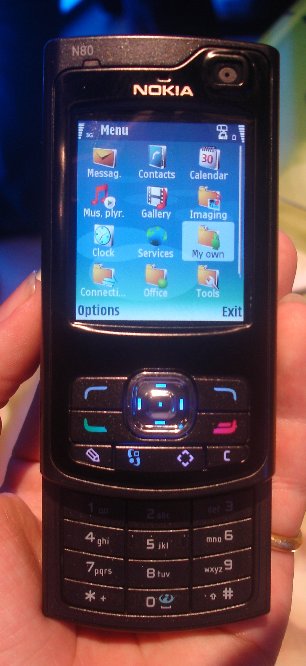
One of the criticisms of existing media players is that they are unconnected and isolationist. You only need to look at popularity of external speakers for the iPod and similar devices to realise that there is a demand to play digital music through more than just headphones.
The advantage on UPnP is that it makes using and sharing your media much easier. The elegance of the solution is that media can be played back on any compatible device, be it your own system, the system at your friend's house or the system in your hotel room (though do not expect hotels to catch on to UPnP too quickly, it threatens their lucrative entertainment revenue streams). It is not hard to envisage a house that has multiple UPnP devices scattered throughout the house. How about music from your phone in your UPnP shower? In a sense the UPnP compatible phone becomes the universal media playback remote control and with memory capacities going up and prices coming down it makes sense to store more of your music on your phone. It is, after all, a device that is nearly always with you.
You will also be able to connect to other devices and download content from them on to your phone (streaming works only from the phone, not to the phone), for example you could connect to your computer and download new music or video files.
To begin with, this UPnP support around the home will most likely be provided by add on boxes (wireless digital media players), but in due course UPnP functionality will be built into devices. Many of the existing wireless media streaming devices (such as the Phillips Stremium range or the Netgear MP101) already support UPnP and so, unlike DVB-H, has already arrived as a technology in many homes. Adding UPnP functionality to an existing PC on a wireless network is as simple as installing an UPnP software server (such as Windows Media Connect or Twonkyvision Media Server ).
Convergence UPnP and the Digital Home
With features such as UPnP (play music on any device anywhere wirelessly), Bluetooth 2.0 (wireless stereo headsets), 3G and Wi-Fi Connectivity (music download/purchase over the air) the N80 is the most feature rich and powerful digital media playback device on the market. Imagine the reaction that wireless headphones, wireless music sharing and playback around the home and over the air song download and purchase would get if they were features announced in a new iPod and you can start to grasp the significance of the feature set of the N80.
The smartphone is often touted as the ultimate convergence device, and the N80 is just one more step along that road. Nokia made it clear they see the N80 at the heart of the digital home with UPnP, with its auto-discovery and remote control properties as the enabling standard. But it is also clear that this is just the first stage and we can expect to see increasing integration with other devices around the home in the future, which will be achieved through the Digital Living Network Alliance (DLNA) 1.5 guidelines (which aims to enhance interoperability and user experience).
Conclusion
The N80 is a very powerful device which outclasses all of its competitors. In providing a well integrated, user friendly and feature rich convergence device which maintains the phone origins it comes from, the strengths of Symbian OS 9 and Series 60 3rd Edition are on show in the N80. This is a device with acronyms, specifications and technology aplenty, plus a stylish design. But it also represents something more...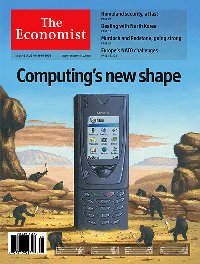 In November 2001 Jorma Ollila and Anssi Vanjoki stood together on the stage in Barcleona at the opening on the NMC Conference to announce the Nokia 7650 - the very first Series 60 smartphone produced by Nokia. From the same stage four years later, Ollila and Vanjoki stood together again, possibly for the last time, to announce the N-Series N80, the latest and most powerful Series 60 smartphone.
In November 2001 Jorma Ollila and Anssi Vanjoki stood together on the stage in Barcleona at the opening on the NMC Conference to announce the Nokia 7650 - the very first Series 60 smartphone produced by Nokia. From the same stage four years later, Ollila and Vanjoki stood together again, possibly for the last time, to announce the N-Series N80, the latest and most powerful Series 60 smartphone.
In design and size the 7650 and N80 are reminiscent of each other, but appearances can be deceptive, because these phones are from different eras. Comparing the two phones we have seen the internal memory increase ten-fold and external memory add another five-hundred-fold increase, the screen resolution double, the camera resolution increased three-fold, the data speed increased eight-fold through 3G technology, the addition of USB and Wi-Fi connectivity, the continuing evolution and support of standards such as Bluetooth, Visual Radio, UPnP and the OMA specifications, the addition of music and video functionality, two major software revisions, and much more.
The comparison is a story of four years of development in which the smartphone has moved from the initial concept smartphone to a series of feature-rich and powerful multimedia computers which will sell 100 million units in 2006. For the consumer electronics industry, it is an unprecedented story of product-line creation, growth and success and one that is largely unnoticed by mainstream technology pundits.
In November 2002, The Economist featured the Nokia 7650 on its cover, saying it heralded 'Computing's new shape'. Three years on, the N80 is the natural successor to the 7650, both in terms of significance and iconic design. The 7650 signaled the coming of the smartphone, I think the N80 heralds fulfillment of the early promise; to borrow a phrase, the 7650 was the beginning, the N80 is the end of the beginning.
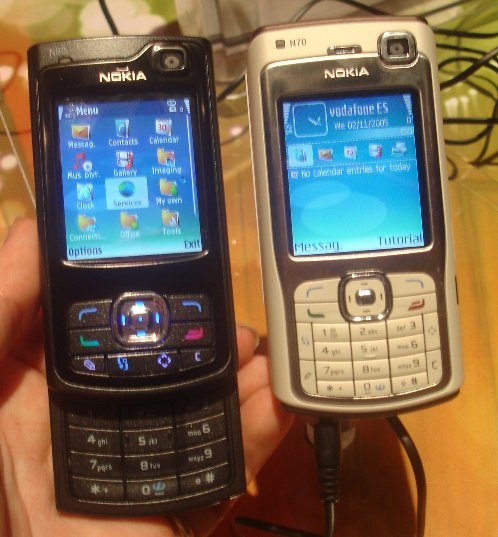
Update: Further Information
In response to some popular queries and questions.
When will the phone be available and how much will it cost?
The phone is scheduled for the first quarter of 2006. The likely release date is March 2006, but it may be into April before the phone become available in significant volumnes, and may take further time to be available via your operator. The unsubsidised cost of the phone is €500 Euros ($590 USD, £350 GBP). While no defintive carrier information has been announced it is expected to be widely available. The FCC have approved a Cingular branded single band WCDMA 1900 version which will be available in the US. Other carrier variants, such as a non WCDMA version, may follow.
Anything you did not like?
Bear in mind this is a preview of an early version. Therefore this is a relatively uncritical piece and until the shipping unit is tested in real world scenarios it is difficult to tell how it will perform. In terms of the features the lack of auto focus in the camera is a negative, and the slide mechanism (no spring) will not be to everyone's tatse.
Will it run Skype?
No official anouncements have been made, but Skype is coming to Symbian and it is likely that this phone will be one of the first to get a working Skype client.
Where can I see the official specifications?
You can find them on the Nseries site.
Further Updates:
The release version will have Bluetooth 1.2 - it will still support EDR [faster data transfers], but the A2DP profile does not appear to be included).
Further answers to FAQs in our Nokia N80 Discussion Forum .
Further questions can be asked in the comment thread below or in our dedicated N80 forum.
